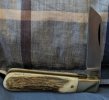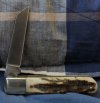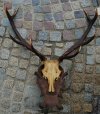I recently received a gorgeous Hartshead Lambsfoot from A. Wright. the scales are stag horn, I believe. I was a little concerned that it was so bright white but it has started browning a bit. It looks really cool to me, now.
I am wondering what causes the coloring, if it can be forced, removed, modified, etc.
Also, can the dark areas be made darker?
I am just curious. This material got me curious.


I am wondering what causes the coloring, if it can be forced, removed, modified, etc.
Also, can the dark areas be made darker?
I am just curious. This material got me curious.





